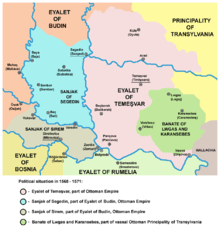Banate of Lugos and Karánsebes
Banate of Lugos and Karánsebes (Hungarian: Karánsebesi-Lugosi bánság, Romanian: Banatul de Lugoj-Caransebeș, Serbian: Лугошка и карансебешка бановина / Lugoška i karansebeška banovina) was an administrative territorial entity of the vassal Ottoman Principality of Transylvania in the 16th century. It was located in the south-eastern part of the region of Banat.
| Banate of Lugos and Karánsebes Karánsebesi-Lugosi bánság Banatul de Lugoj-Caransebeș Лугошка и карансебешка бановина Lugoška i karansebeška banovina | |||||||||
|---|---|---|---|---|---|---|---|---|---|
| Banate of the Ottoman Principality of Transylvania | |||||||||
| 16th century–17th century | |||||||||
 Banate of Lugos and Karansebes in 1571 | |||||||||
| History | |||||||||
• Established | 16th century | ||||||||
• Disestablished | 17th century | ||||||||
| |||||||||
| Today part of | Romania, Serbia | ||||||||
History
The Banate of Lugos and Karánsebes was formed gradually between 1526–1536, after the battle of Mohács, when the Banate of Severin was divided. Its eastern side, from Orsova (present-day Orșova), came under the jurisdiction of the Wallachian ruler. In the western part, it was formed this new political and military border entity.
In 1658, the new prince of Transylvania, Ákos (Acațiu) Barcsay, ceded the region to the Ottoman Empire.
Cities
Banate of Lugoj and Caransebeș included the following cities:
Bans of Lugoj and Caransebeș
- Michael of Somlya (1536)
- Petar Petrović (1544–1549)
- Ioan Gleșan (1552)
- Grigore Bethlen of Ictar (1563)
- Gabriel Bethlen of Ictar (1564)
- Ștefan Trompa (1575–1577)
- Đorđe Palotić (fl. 1594)
- Paul Keresztesy (1605–1606) and (1610–1613)
See also
- Banat
- Principality of Transylvania (1571–1711)